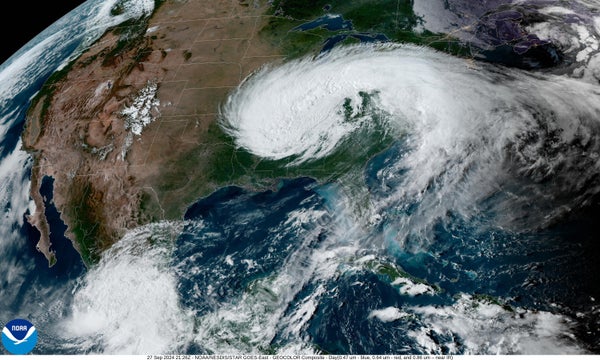Hurricane Season Is Soon—NOAA Says It’s Ready, but Weather Experts Are Worried
May 23, 20255 min readNOAA Says It’s Ready for Hurricane Season, but Weather Experts Are WorriedAs hurricane season approaches, thousands of weather and disaster experts have raised concerns about NOAA and NWS budget cuts and staffing shortagesBy Chelsea Harvey & E&E News The remnants of Hurricane Helene begin to dissipate over the United States in this NOAA satellite from Sept. 27, 2024. Space Image Archive/Alamy Stock PhotoCLIMATEWIRE | The National Oceanic and Atmospheric Administration insists it’s ready for the above-average hurricane season that meteorologists expect this summer.But scientists across the country are sounding the alarm about personnel shortages and budget cuts, which they say could strain the agency’s resources and risk burnout among its staff.The tension was on display Thursday as NOAA officials announced the agency’s annual Atlantic hurricane season outlook.On supporting science journalismIf you're enjoying this article, consider supporting our award-winning journalism by subscribing. By purchasing a subscription you are helping to ensure the future of impactful stories about the discoveries and ideas shaping our world today.This year’s projection suggests a 60 percent chance of an above-average season, with anywhere from 13 to 19 named storms and three to five major hurricanes. That’s compared with the long term average of 14 named storms and three major hurricanes in a typical season.NOAA hosted this year’s announcement in Gretna, Louisiana, just outside New Orleans, in a nod to the upcoming 20th anniversary of Hurricane Katrina, which devastated the city in 2005. The agency has made significant strides in hurricane forecasts and warnings over the past two decades, officials said — including life-saving improvements in hurricane track and intensity predictions and new forms of modeling, radar and observation technology.“These improvements and collaborative efforts demonstrate that NOAA is now more prepared than ever for what hurricane season may bring,” said NOAA chief of staff Laura Grimm.But reporters at the briefing pushed back on that certainty, noting that recent cuts have eroded some of the agency’s observation capabilities and left dozens of local National Weather Service offices understaffed.Thousands of scientists have raised the same concerns over the past few months, as the Trump administration has reduced NOAA staff by more than 2,200 people, or around 20 percent of its former workforce. The administration also has proposed a plan to dramatically reorganize the agency and effectively eliminate its climate research operations.The National Weather Service alone has lost around 550 staff members since January, leaving the agency scrambling to fill at least 155 key job openings at regional offices around the country; some include top positions such as meteorologist-in-charge.At least 3,300 scientists have signed an open letter to Commerce Secretary Howard Lutnick, who leads the department that oversees NOAA, warning that cuts to the agency could have “dire consequences for American lives and livelihoods.”And earlier this month, five former National Weather Service directors published an open letter warning that the recent cuts mean NWS staff members face “an impossible task” when it comes to maintaining their usual level of service.Volunteers work to remove debris and mud from a flooded home on Edwards Avenue in Beacon Village neighborhood after a catastrophic flooding caused from Hurricane Helene caused the Swannanoa river to swell to record levels October 5, 2024 in Swannanoa, North Carolina.Steve Exum/Getty Images“Some forecast offices will be so short-staffed that they may be forced to go to part time services,” the letter warned. “Our worst nightmare is that weather forecast offices will be so understaffed that there will be needless loss of life.”NOAA officials sidestepped these worries at Thursday's presentation, insisting the National Hurricane Center’s headquarters is fully staffed and prepared for the upcoming season.“We had some folks go,” said National Weather Service director Ken Graham. “But we’re gonna make sure that we have everything that we have on the front lines. Every warning’s gonna go out.”It remains unclear how the agency plans to address the dozens of vacancies at local offices across the country, including some hurricane-prone areas along the East and Gulf coasts. Lawmakers have reported that NOAA managers are encouraging staff members to pursue reassignments to understaffed offices, while the former NWS directors noted that staff members have been known to sleep in their offices to avoid gaps in coverage.That scenario played out recently at a regional office in Jackson, Kentucky, that is so understaffed that it’s no longer able to regularly operate overnight. When deadly tornadoes struck the region earlier this month, meteorologists there made the decision to call all hands on deck to staff the overnight shift and ensure the quality of forecasts and warnings, CNN reported.But experts say it’s an unsustainable system, which could lead to burnout this summer when disasters like hurricanes, floods and wildfires are at their peak.“It’s not sustainable if we have multiple high-impact weather events,” said Brian LaMarre, a former meteorologist-in-charge at the National Weather Service’s Tampa Bay Area office and founder of the weather consulting service Inspire Weather. “It doesn't matter if we’re forecasting above normal or below normal, it only takes that one storm to truly make a significant impact.”Risks rise with global temperaturesMeanwhile, Atlantic hurricane seasons are expected to grow more intense as global temperatures rise.This year’s projections for an active season are partly linked to above-average ocean temperatures, which help fuel the formation of tropical cyclones. This year’s temperatures aren’t as warm as they were the past two seasons, when ocean waters broke daily records for more than a year. But they’re still warm enough to cause concern.Natural climate cycles play a part in each year’s hurricane outlook. Every few years, the planet shifts between El Niño and La Niña events, which cause temperatures in the Pacific Ocean to grow periodically warmer and cooler. These events influence weather and climate patterns around the globe, with El Niño typically associated with below-average Atlantic hurricane activity and La Niña contributing to more active seasons.This year, the planet is in a neutral phase, meaning Pacific Ocean temperatures are close to average. With no El Niño event to hinder the formation of tropical cyclones, warmer-than-average Atlantic temperatures are likely to fuel an active season.Climate change is partly to blame. Scientists warn that greenhouse gas emissions and continued global warming are gradually raising sea surface temperatures across much of the world. Studies suggest that hurricanes are intensifying faster and growing stronger as a result, leading to a greater risk of major storms striking the United States.Last year’s Atlantic hurricane season was a stark reminder of the growing dangers.Hurricane Beryl smashed records in July as the earliest Atlantic hurricane to achieve a Category 4, before eventually expanding to a Category 5. Hurricane Milton rapidly intensified into the season’s second Category 5 storm — and although it weakened to a Category 3 before making landfall, it dropped historic rainfall and spawned dozens of tornadoes along the Florida coast.And Hurricane Helene made history as an unusually large and fast-moving storm, hitting Florida as a Category 4 and barreling inland, where it carved a path of destruction through Appalachia. It became the deadliest storm to strike the mainland U.S. since Hurricane Katrina.Reprinted from E&E News with permission from POLITICO, LLC. Copyright 2025. E&E News provides essential news for energy and environment professionals.
#hurricane #season #soonnoaa #says #its
Hurricane Season Is Soon—NOAA Says It’s Ready, but Weather Experts Are Worried
May 23, 20255 min readNOAA Says It’s Ready for Hurricane Season, but Weather Experts Are WorriedAs hurricane season approaches, thousands of weather and disaster experts have raised concerns about NOAA and NWS budget cuts and staffing shortagesBy Chelsea Harvey & E&E News The remnants of Hurricane Helene begin to dissipate over the United States in this NOAA satellite from Sept. 27, 2024. Space Image Archive/Alamy Stock PhotoCLIMATEWIRE | The National Oceanic and Atmospheric Administration insists it’s ready for the above-average hurricane season that meteorologists expect this summer.But scientists across the country are sounding the alarm about personnel shortages and budget cuts, which they say could strain the agency’s resources and risk burnout among its staff.The tension was on display Thursday as NOAA officials announced the agency’s annual Atlantic hurricane season outlook.On supporting science journalismIf you're enjoying this article, consider supporting our award-winning journalism by subscribing. By purchasing a subscription you are helping to ensure the future of impactful stories about the discoveries and ideas shaping our world today.This year’s projection suggests a 60 percent chance of an above-average season, with anywhere from 13 to 19 named storms and three to five major hurricanes. That’s compared with the long term average of 14 named storms and three major hurricanes in a typical season.NOAA hosted this year’s announcement in Gretna, Louisiana, just outside New Orleans, in a nod to the upcoming 20th anniversary of Hurricane Katrina, which devastated the city in 2005. The agency has made significant strides in hurricane forecasts and warnings over the past two decades, officials said — including life-saving improvements in hurricane track and intensity predictions and new forms of modeling, radar and observation technology.“These improvements and collaborative efforts demonstrate that NOAA is now more prepared than ever for what hurricane season may bring,” said NOAA chief of staff Laura Grimm.But reporters at the briefing pushed back on that certainty, noting that recent cuts have eroded some of the agency’s observation capabilities and left dozens of local National Weather Service offices understaffed.Thousands of scientists have raised the same concerns over the past few months, as the Trump administration has reduced NOAA staff by more than 2,200 people, or around 20 percent of its former workforce. The administration also has proposed a plan to dramatically reorganize the agency and effectively eliminate its climate research operations.The National Weather Service alone has lost around 550 staff members since January, leaving the agency scrambling to fill at least 155 key job openings at regional offices around the country; some include top positions such as meteorologist-in-charge.At least 3,300 scientists have signed an open letter to Commerce Secretary Howard Lutnick, who leads the department that oversees NOAA, warning that cuts to the agency could have “dire consequences for American lives and livelihoods.”And earlier this month, five former National Weather Service directors published an open letter warning that the recent cuts mean NWS staff members face “an impossible task” when it comes to maintaining their usual level of service.Volunteers work to remove debris and mud from a flooded home on Edwards Avenue in Beacon Village neighborhood after a catastrophic flooding caused from Hurricane Helene caused the Swannanoa river to swell to record levels October 5, 2024 in Swannanoa, North Carolina.Steve Exum/Getty Images“Some forecast offices will be so short-staffed that they may be forced to go to part time services,” the letter warned. “Our worst nightmare is that weather forecast offices will be so understaffed that there will be needless loss of life.”NOAA officials sidestepped these worries at Thursday's presentation, insisting the National Hurricane Center’s headquarters is fully staffed and prepared for the upcoming season.“We had some folks go,” said National Weather Service director Ken Graham. “But we’re gonna make sure that we have everything that we have on the front lines. Every warning’s gonna go out.”It remains unclear how the agency plans to address the dozens of vacancies at local offices across the country, including some hurricane-prone areas along the East and Gulf coasts. Lawmakers have reported that NOAA managers are encouraging staff members to pursue reassignments to understaffed offices, while the former NWS directors noted that staff members have been known to sleep in their offices to avoid gaps in coverage.That scenario played out recently at a regional office in Jackson, Kentucky, that is so understaffed that it’s no longer able to regularly operate overnight. When deadly tornadoes struck the region earlier this month, meteorologists there made the decision to call all hands on deck to staff the overnight shift and ensure the quality of forecasts and warnings, CNN reported.But experts say it’s an unsustainable system, which could lead to burnout this summer when disasters like hurricanes, floods and wildfires are at their peak.“It’s not sustainable if we have multiple high-impact weather events,” said Brian LaMarre, a former meteorologist-in-charge at the National Weather Service’s Tampa Bay Area office and founder of the weather consulting service Inspire Weather. “It doesn't matter if we’re forecasting above normal or below normal, it only takes that one storm to truly make a significant impact.”Risks rise with global temperaturesMeanwhile, Atlantic hurricane seasons are expected to grow more intense as global temperatures rise.This year’s projections for an active season are partly linked to above-average ocean temperatures, which help fuel the formation of tropical cyclones. This year’s temperatures aren’t as warm as they were the past two seasons, when ocean waters broke daily records for more than a year. But they’re still warm enough to cause concern.Natural climate cycles play a part in each year’s hurricane outlook. Every few years, the planet shifts between El Niño and La Niña events, which cause temperatures in the Pacific Ocean to grow periodically warmer and cooler. These events influence weather and climate patterns around the globe, with El Niño typically associated with below-average Atlantic hurricane activity and La Niña contributing to more active seasons.This year, the planet is in a neutral phase, meaning Pacific Ocean temperatures are close to average. With no El Niño event to hinder the formation of tropical cyclones, warmer-than-average Atlantic temperatures are likely to fuel an active season.Climate change is partly to blame. Scientists warn that greenhouse gas emissions and continued global warming are gradually raising sea surface temperatures across much of the world. Studies suggest that hurricanes are intensifying faster and growing stronger as a result, leading to a greater risk of major storms striking the United States.Last year’s Atlantic hurricane season was a stark reminder of the growing dangers.Hurricane Beryl smashed records in July as the earliest Atlantic hurricane to achieve a Category 4, before eventually expanding to a Category 5. Hurricane Milton rapidly intensified into the season’s second Category 5 storm — and although it weakened to a Category 3 before making landfall, it dropped historic rainfall and spawned dozens of tornadoes along the Florida coast.And Hurricane Helene made history as an unusually large and fast-moving storm, hitting Florida as a Category 4 and barreling inland, where it carved a path of destruction through Appalachia. It became the deadliest storm to strike the mainland U.S. since Hurricane Katrina.Reprinted from E&E News with permission from POLITICO, LLC. Copyright 2025. E&E News provides essential news for energy and environment professionals.
#hurricane #season #soonnoaa #says #its
·131 Views







